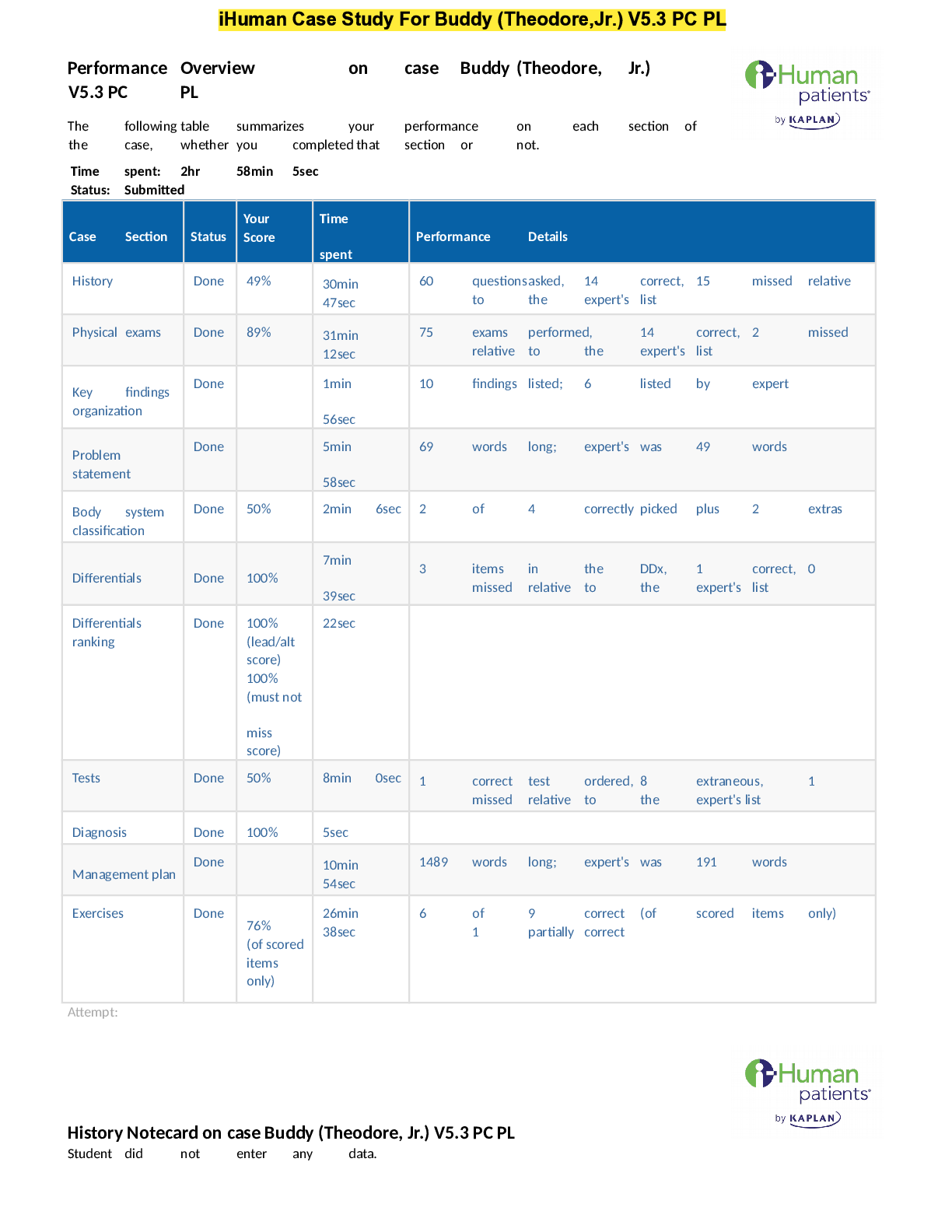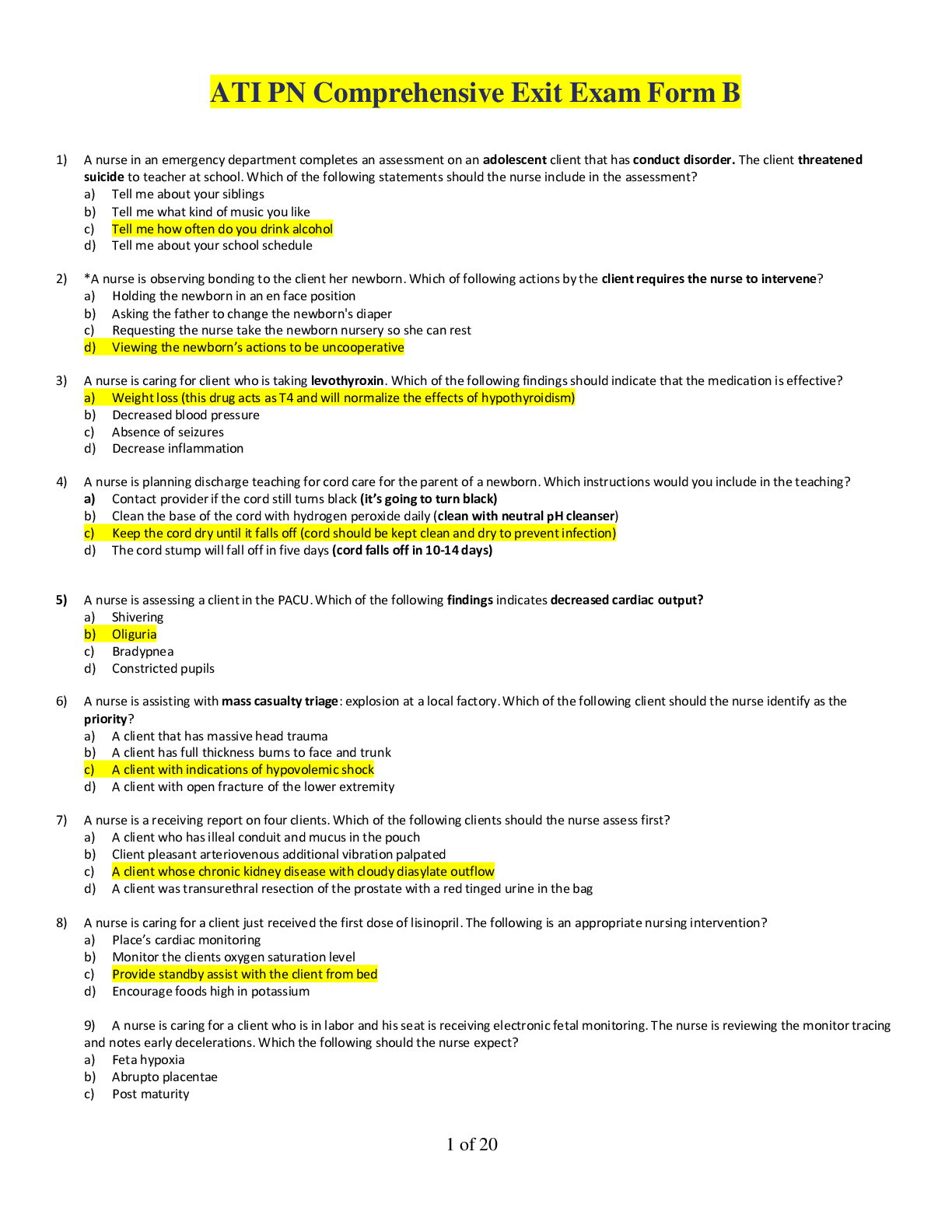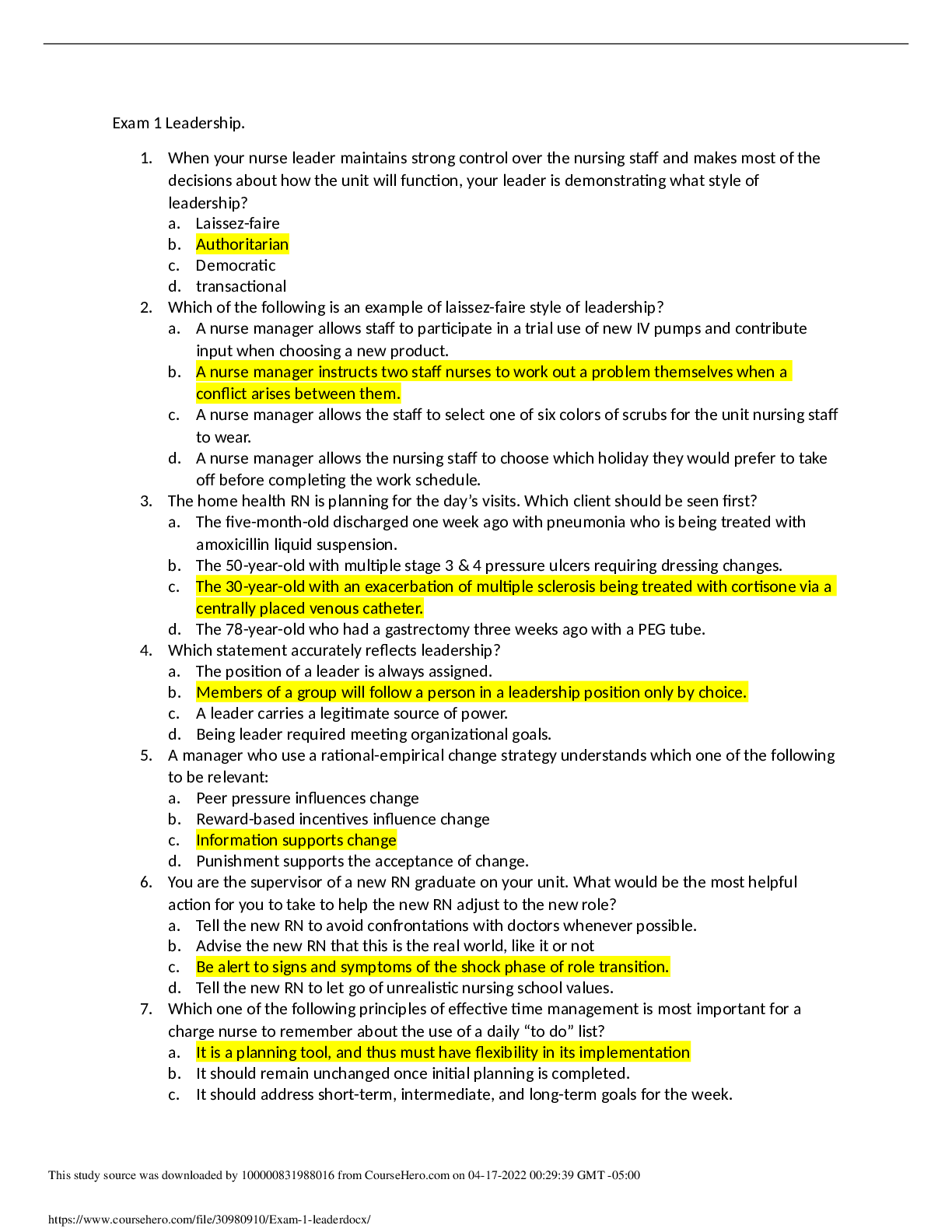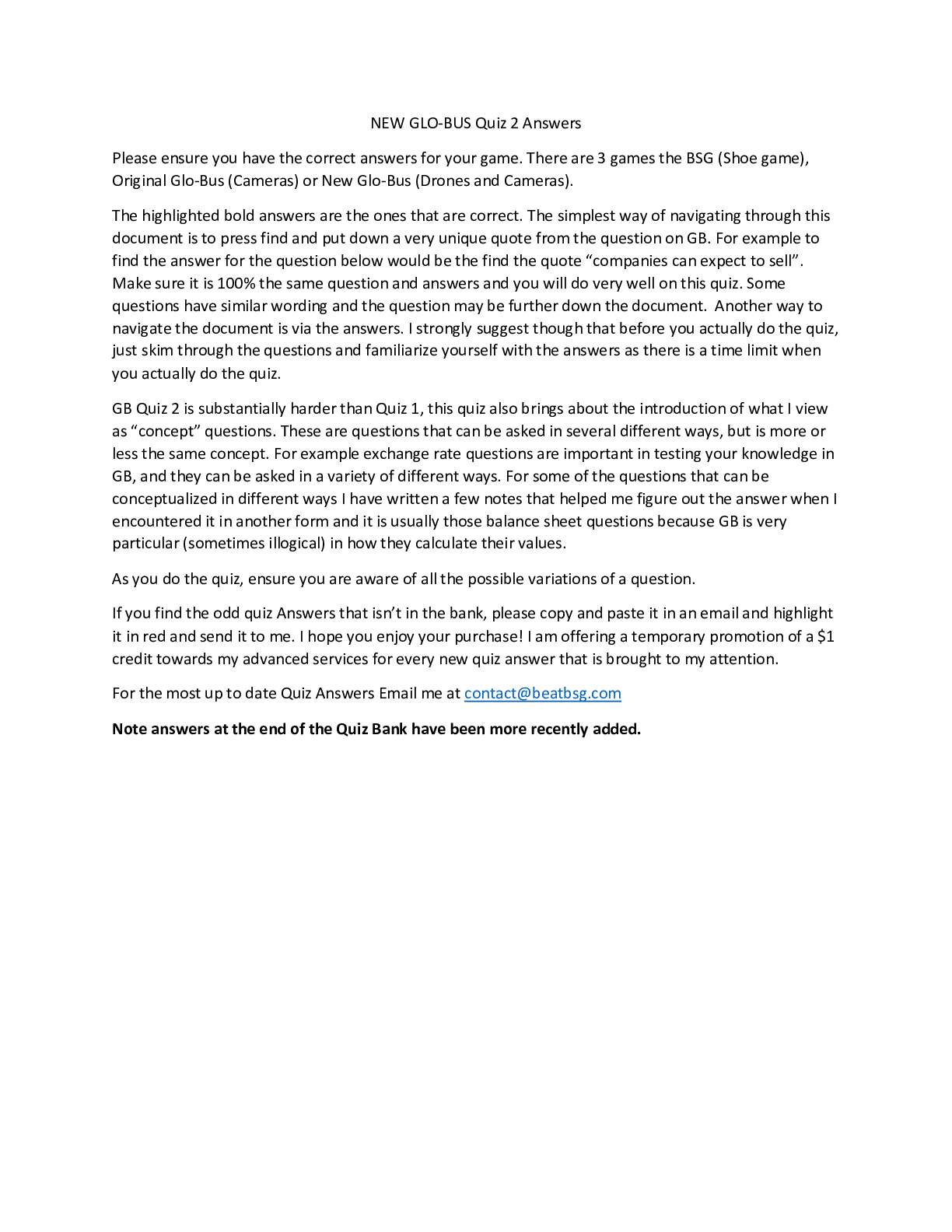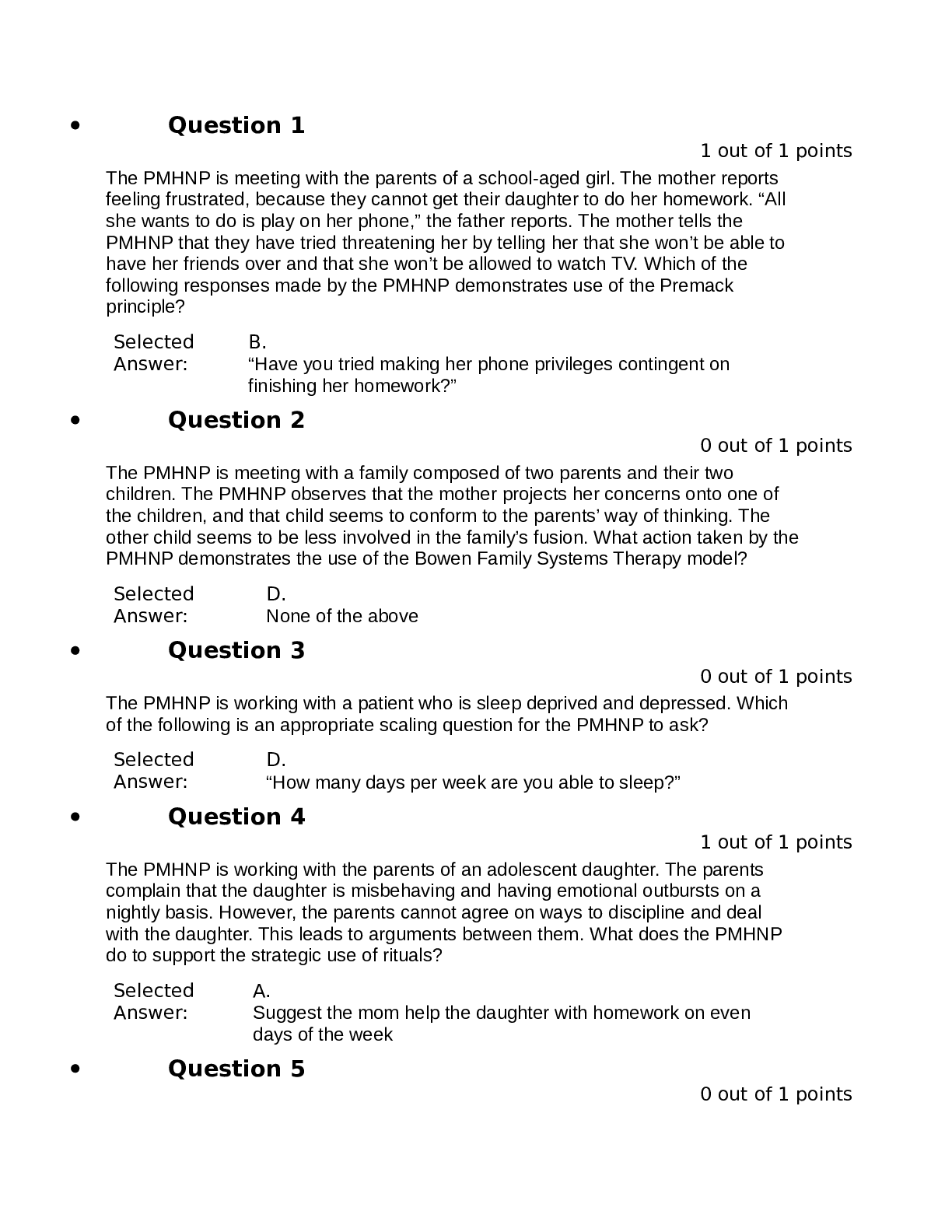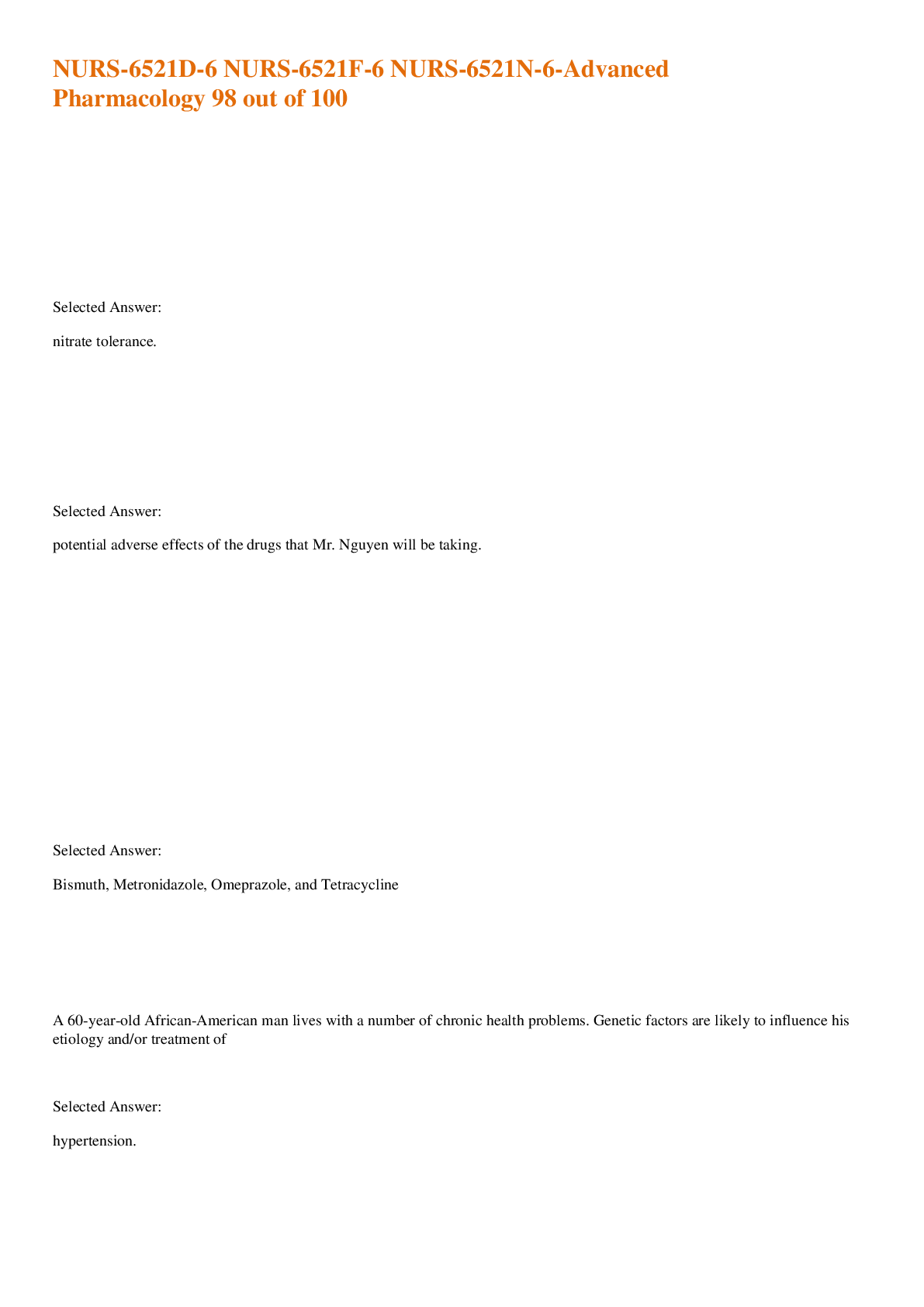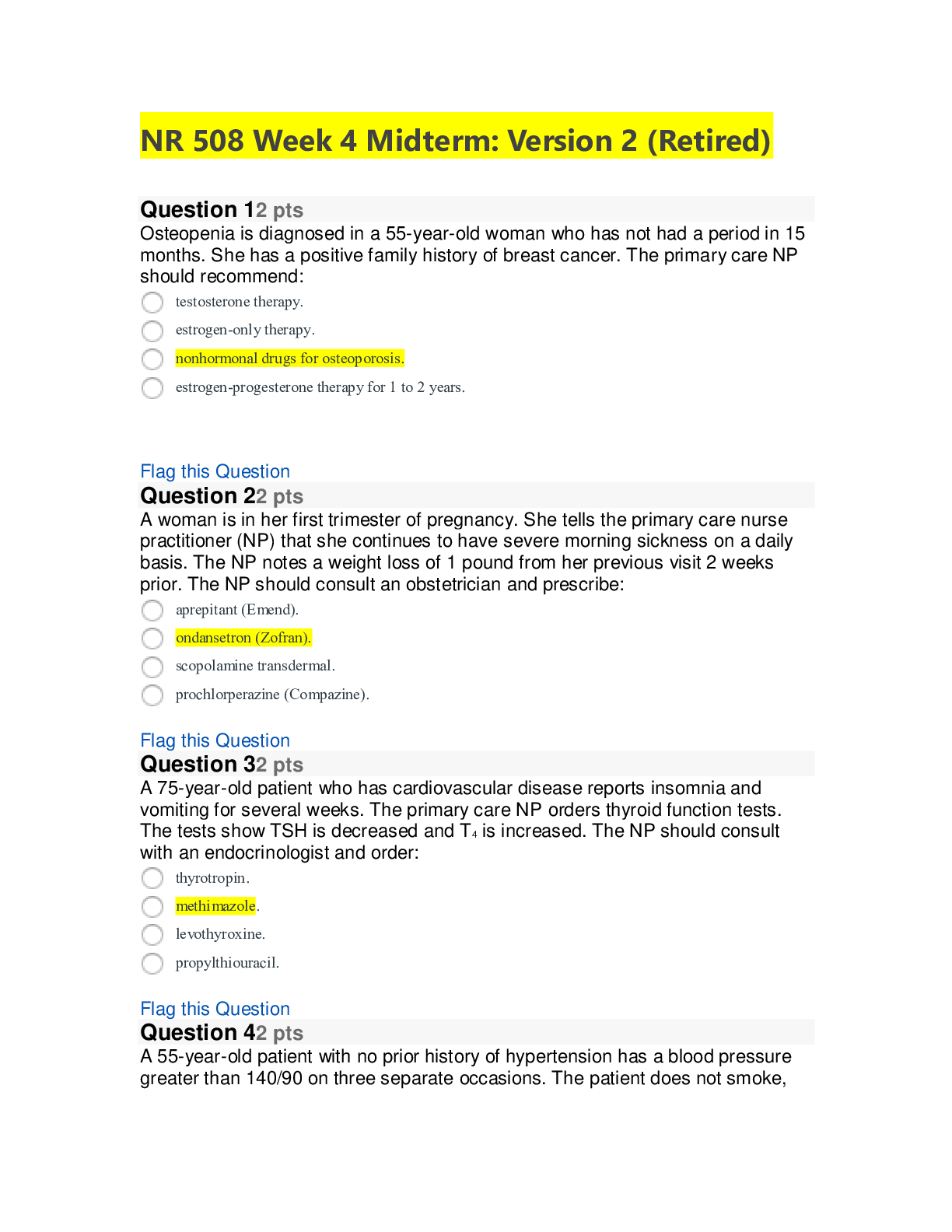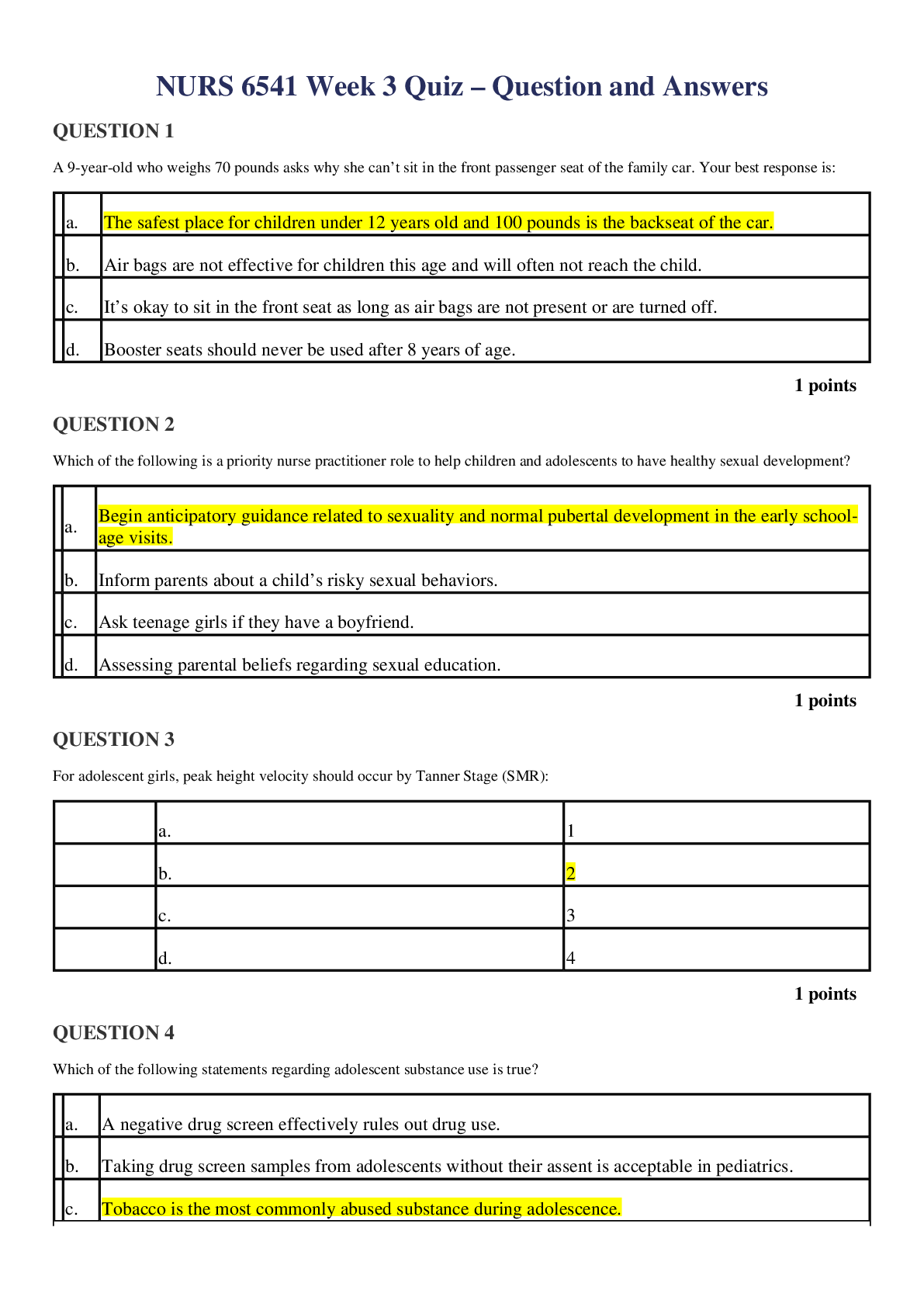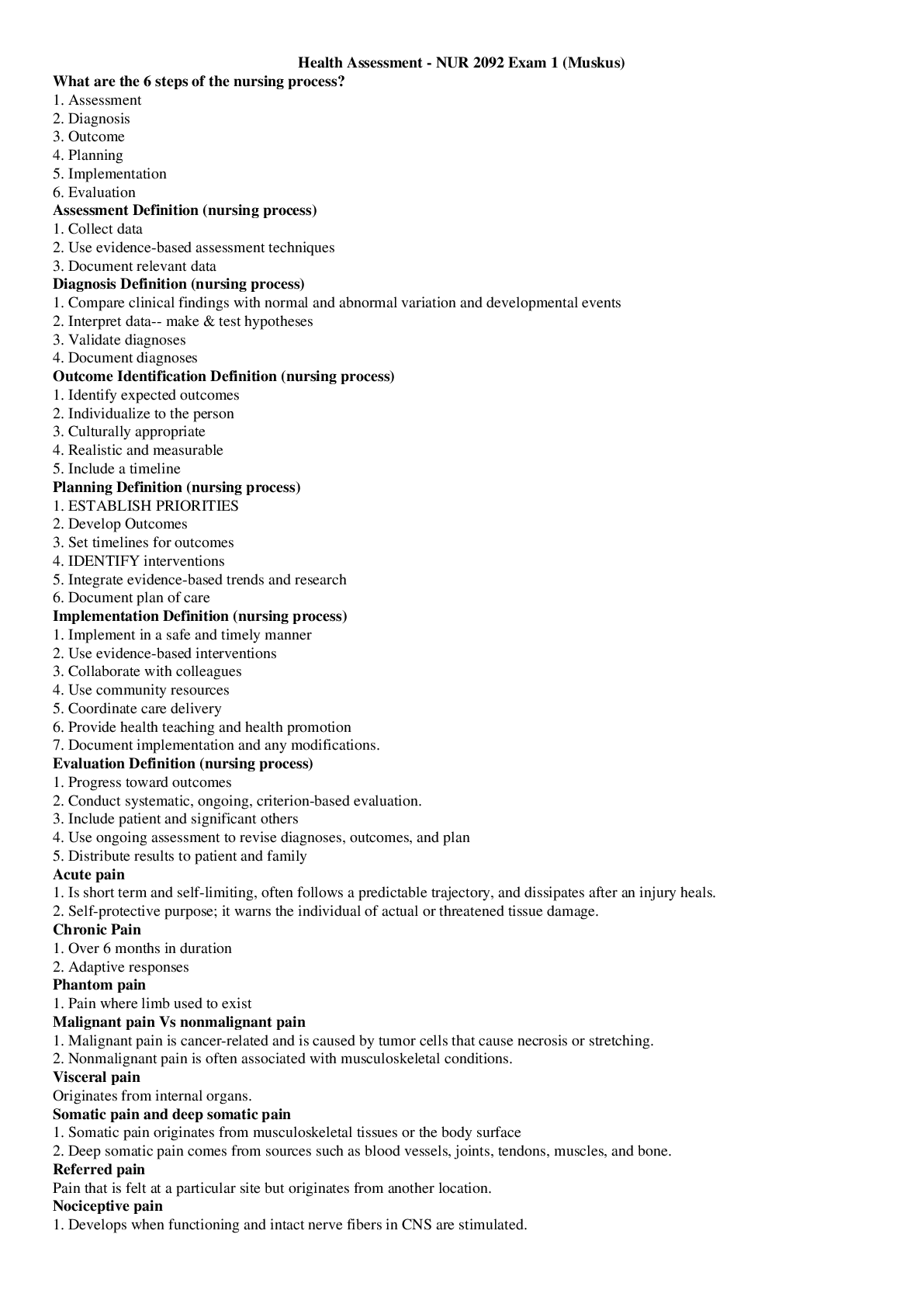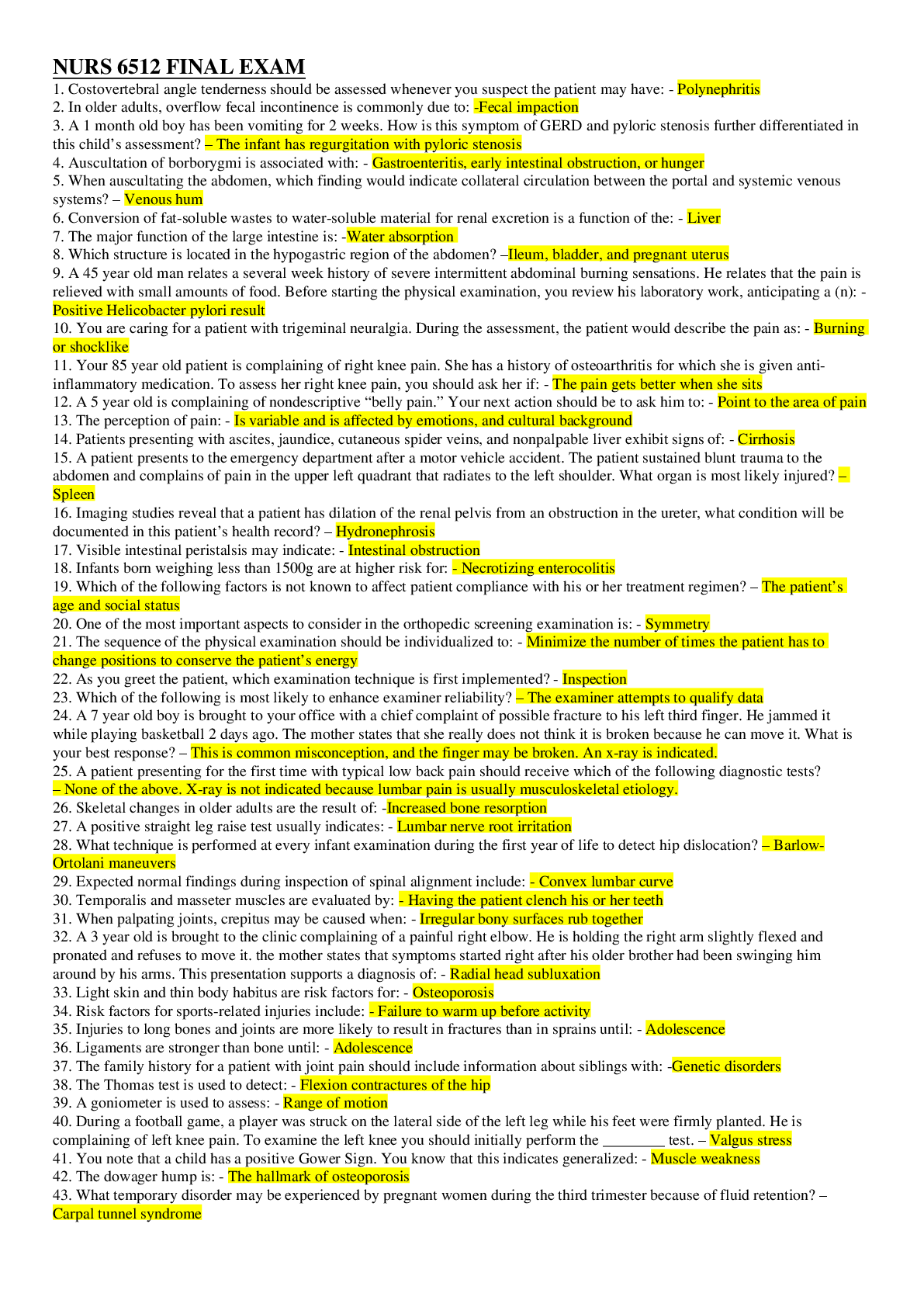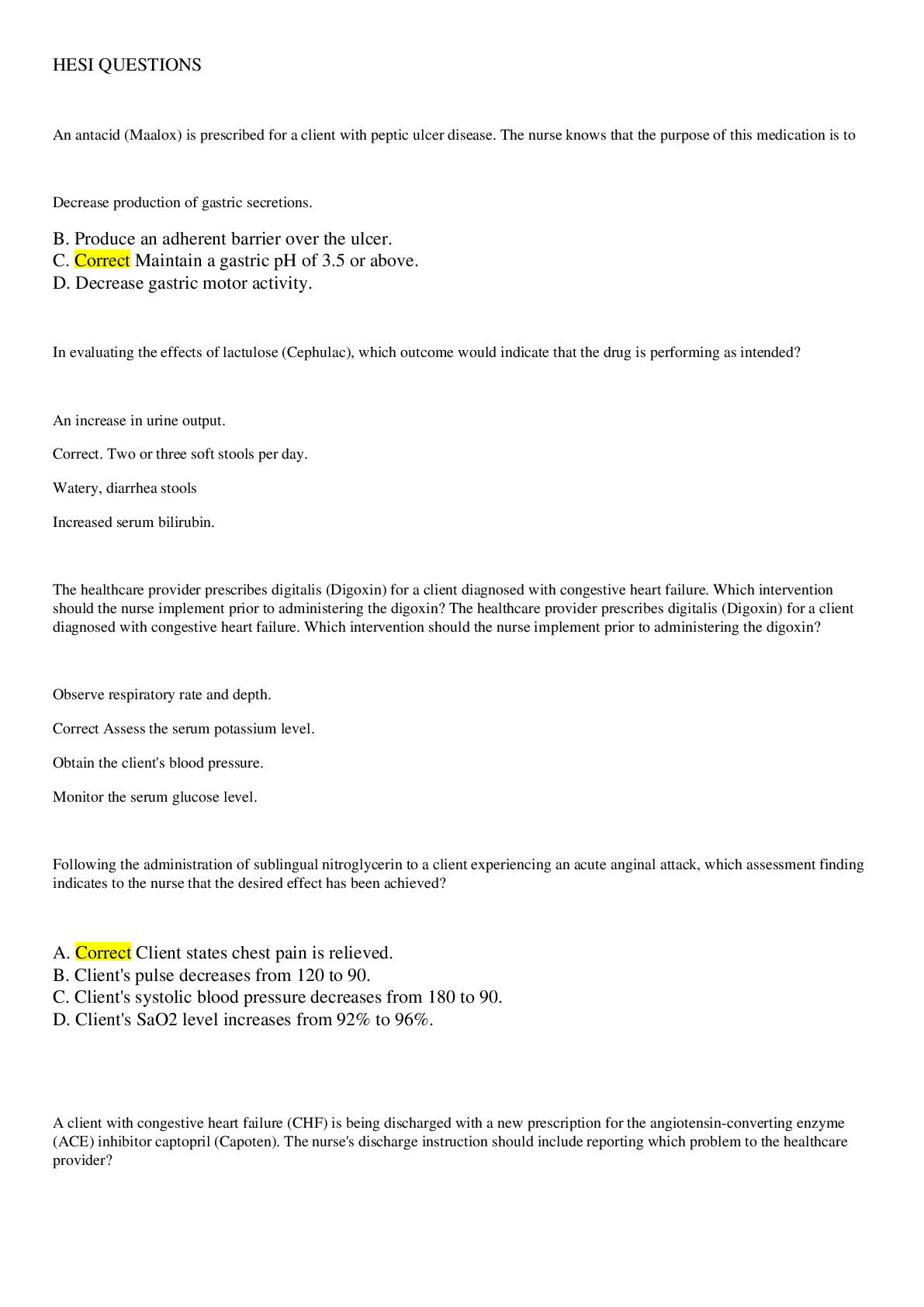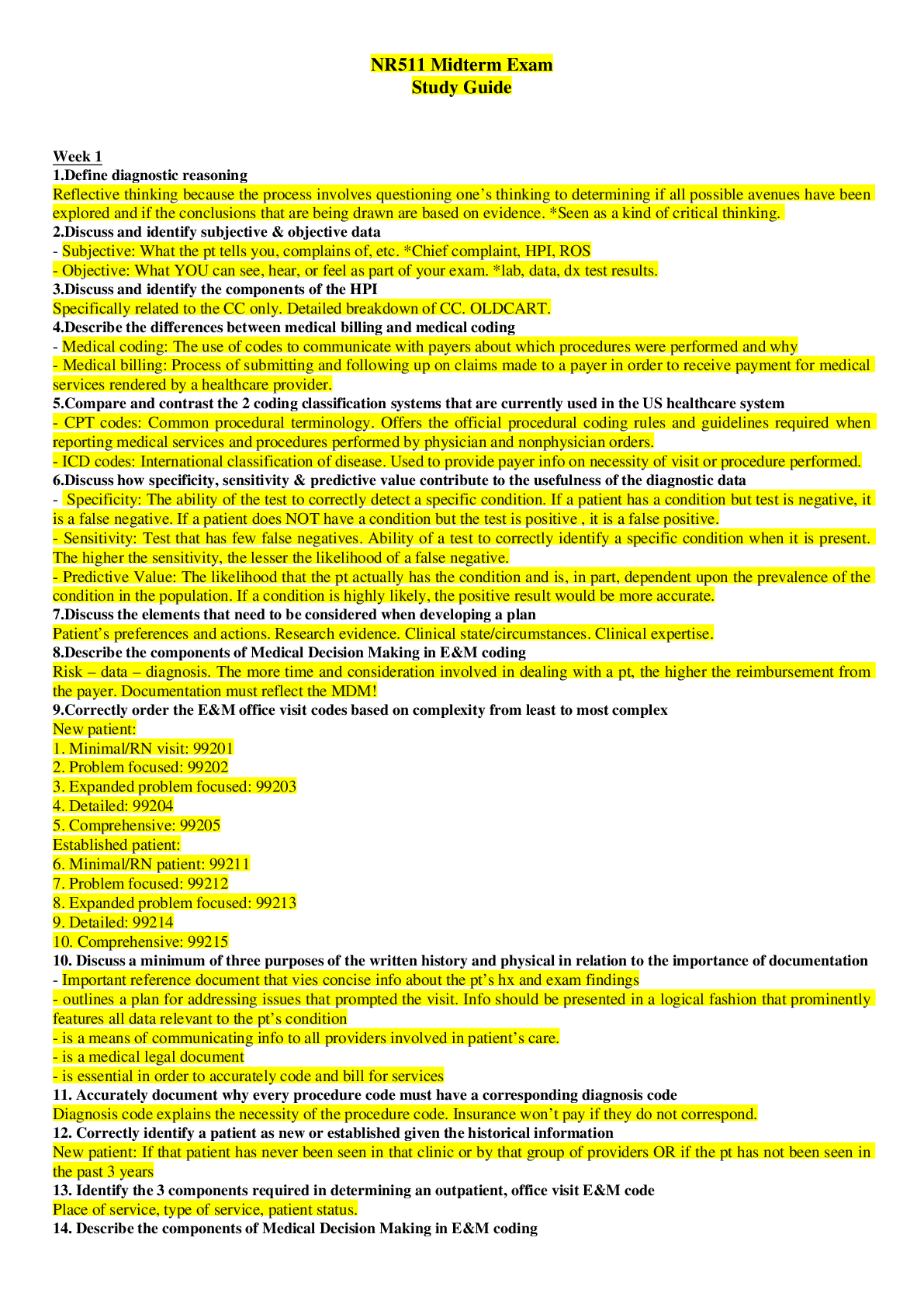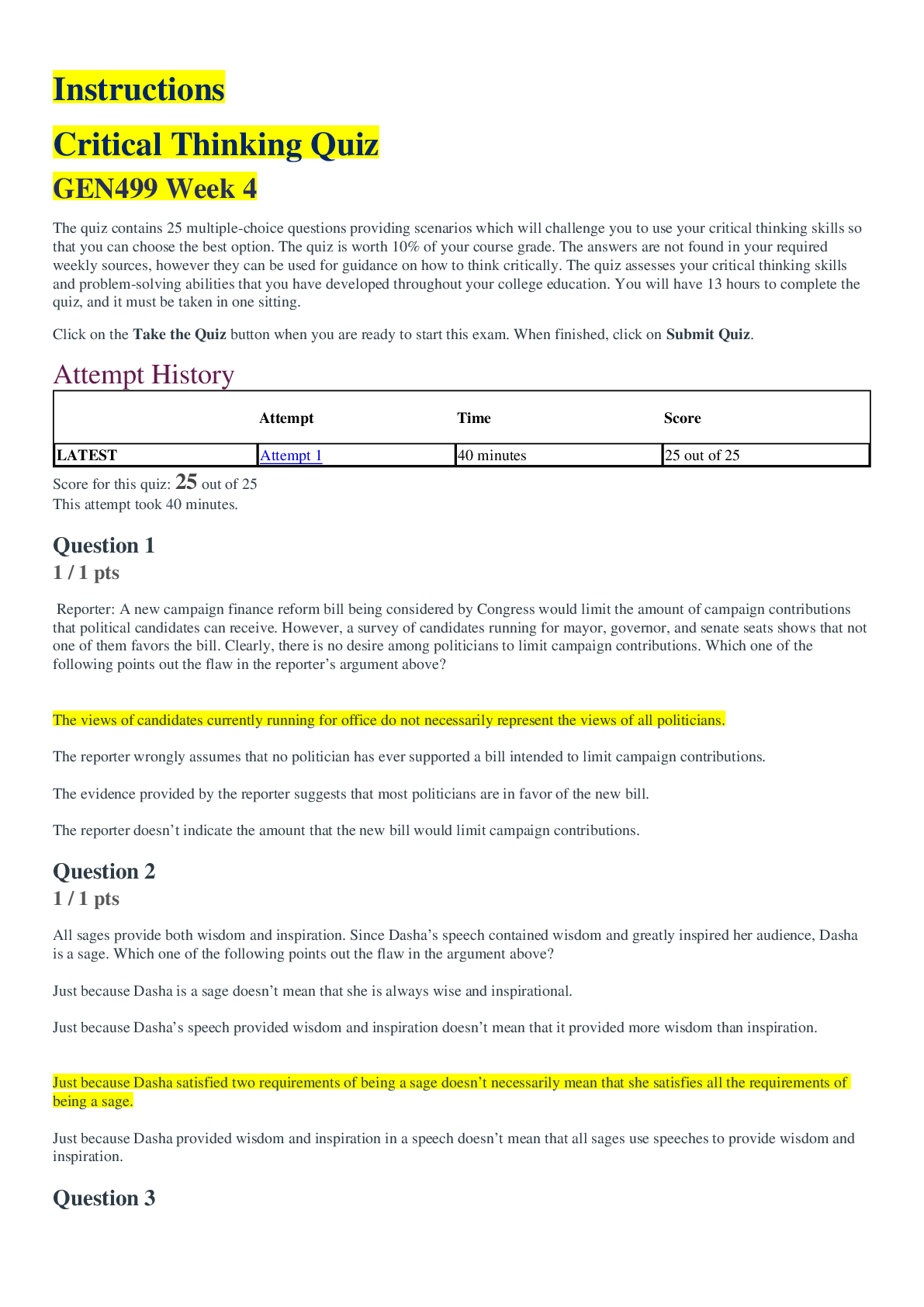NUR 192 Geriatric Nursing - Final Exam( Download To Score An A)
Document Content and Description Below
Geriatric Nursing – Final Exam 1) Demographic profile of the elderly in the United States a) Division of the age group – young old, middle old, old-old i) 65-74 = young old ii) 75-85 = middl... e old iii) 85+ = old old iv) 90+ = nonagenarians , 100+ = centenarians, *75+ = (physical, cognitive, social issues = frail elderly b) Mandatory retirement age i) Usually 65 c) Increase in life expectancy: • Advancements in medicine: (diagnostic test like cancer screenings [PSAs and mammograms, colonoscopies] and technology) o #1 cancer in elderly males Prostate CA (Diagnostic test for Prostate CA: PSA: prostate specific antigen) • Aging baby boomers • Improved economic situations lead to a higher life expectancy • Developed vs developing countries (i.e. Japan and Italy have highest life expectancies) • *Wellness (levels of prevention) o Primary prevention: illness not present, trying to prevent it leading a healthy lifestyle (diet, exercise) o Secondary: early detection of illness o Tertiary: rehabilitation and prevention of further complications • Decreased infant mortality • Vaccinations (form of primary prevention) 2) Myths about the elderly a) Elderly patients no longer have sex b) Elderly patients are grumpy/disagreeable i) Illness reactive depression in reaction to chronic illness ii) Isolation iii) Mostly widows/widowers iv) Relocation/separation from family v) Often experiencing cognitive decline c) Dementia (*considered an illness or condition, NOT a normal part of aging) i) Cognitive impairment/mental decline (1) Loss of memory, many causes brain damage, stroke, Alzheimer’s, etc. ii) Bad odors/incontinence (an involuntary loss of urine and defecation) (1) Incontinence is NOT a part of the natural aging process iii) Loss of prostate function d) Polypharmacy i) Using multiple drugs at once cascading polypharmacy: side effects from multiple drugs ii) Adverse meds effects are often overlooked in older adults because they are mistakenly attributed to aging or pathologic conditions iii) Medication reconciliation: evidence-based intervention that has been widely implemented in health care settings (1) Process of identifying a patient’s medication errors such as omissions, duplications, dosing errors, or drug interactions during transitions in care (2) Nursing interventions for successful med reconciliation: 3) Ageism (Robert Butler, 1968) a) Prejudice/stereotypes applied to older people sheerly on the basis of their age b) Younger adults develop ageist attitudes to protect themselves from death anxiety, whereas older adults develop ageist attitudes because of negative stereotypes about their own group 4) Theories of aging a) Biological – free radical theory; caloric restriction theory; wear and tear i) Free radical theory of aging (1) Free radicals are ionized oxygen molecules that are highly unstable because they have an extra electron. They are waste products of metabolism and they can damage cells. Healthy bodies have protective mechanisms that can remove and repair damaged cells (2) However, these mechanisms become less effective with increased age and cellular damage becomes cumulative ii) Caloric restriction theory (1) Numerous animal studies have found that reducing caloric intake by 30-40% without causing malnutrition results in enhanced ability to protect cells, increased resistance to stress, and overall longer and healthier life expectancy iii) Wear and tear theory (1) the human body is like a machine. It functions well for a certain time and broken parts can be fixed or replaced, but eventually it stops working because of accumulated effects of wear and tear. Longevity is affected by the genetic components as well as by the care provided (2) for humans, the wearing out process is exacerbated by harmful factors such as stress, disease, smoking, poor diet and alcohol abuse b) Psychological/social – Erik Erikson’s theory; activity theory; disengagement theory; continuity theory; Maslow’s theory of needs i) Erik Erikson’s theory (1) Erikson believes that people pass through 8 distinctive developmental stages as they grow and change through life (2) Ego integrity vs despair (a) 8th and final stage (b) Begins at 65 and ends at death (c) Reflecting on one’s life and either moving into feeling satisfied and happy with one’s life or feeling a deep sense of regret ii) Activity theory (1) Older people remain socially and psychologically fit if they remain actively engaged in life (a) i.e. one’s self concept is affirmed through activities associated with various roles and the loss of roles in old age negatively affects life satisfaction (b) Volunteer activities improve life satisfaction, positive affect, and quality of life for older adults iii) Disengagement theory (1) 1st sociologic theory of aging, proposed that a society and older people engage in mutually beneficial process of reciprocal withdrawal to maintain social equilibrium (2) This process occurs systematically and inevitably and is governed by society’s needs, which override individual needs (3) Older people desire this withdrawal are happy when it occurs (4) Reasons (a) retirement (b) loss of spouse through death (c) reduced income (d) shrinking social world (e) declining health iv) Continuity theory (1) Normal aging states that older adults will maintain the same activities, behaviors, relationships as they did in their earlier years of life v) Maslow’s theory of needs (1) 5 categories of basic human needs (a) physiologic needs (b) safety and security needs (c) love and belongingness (d) self-esteem (e) self-actualization (2) the attainment of lower level needs takes priority over high level needs (3) self actualization can occur only when lower level needs are met to some degree (4) people are constantly moving between the levels but always strive toward higher levels (5) self actualized people mature humans who possess such desirable traits as autonomy, creativity, independence, and positive interpersonal relationships 5) Healthy People 2020 a) Source of recommendations for evidence based health promotion interventions b) Implications for the elderly clients i) Objectives related to health promotion activities (1) Increase the proportion of older adults who: (a) use Medicare preventative services benefit (b) engage in light, moderate, or vigorous leisure-time activities (c) are up to date on core clinical preventive services (i.e. colorectal screenings) (d) report confidence in managing their chronic conditions (e) have moderate to severe functional limitations (f) participate in diabetes self-management programs ii) Objectives related to resources for older adults (1) reduce the proportion of community-living older adults with disabilities who have an unmet need for long-term care services and supports (2) reduce the proportion of caregivers who report an unmet need for caregiver support services iii) Objectives related to care of older adults (1) reduce the rate of pressure ulcer-related hospitalizations* (2) reduce the rate of emergency department visits due to falls* iv) Objectives related to elder abuse (1) improve data collection and dissemination of information from states, DC, Native American tribes related to characteristics of victims, perpetrators, and case of elder abuse, neglect and exploitation v) Objectives related to health care workforce (1) increase the proportion of registered nurses with geriatric certification 6) Holistic nursing a) Mind, body, spirit i) Determinants of living long and well: (1) inherit good genes (2) avoid oxidative damage (3) protect from oxidation damage with antioxidants from natural sources (4) maintain optimal weight (5) engage in physical exercise (6) engage in meaning social interactions (7) develop close personal relationships (8) maintain a sense of spiritual connectedness (9) reject ageist stereotypes 7) Life review a) Life review: a progressive return to consciousness of past experiences, particularly unresolved conflicts, for reexamination and reintegration. If the reintegration process is successful, the process gives new significance and meaning to life and prepares the person for death by alleviating fear and anxiety b) Positive effects of life review i) Accepting one’s mortality, righting of old wrongs, taking pride in accomplishments, gaining a sense of serenity, and feeling that one has done one’s best c) How to facilitate a life review i) address both pleasant and unpleasant issues of the past ii) asking about one’s regrets iii) look back on life iv) depression/anger/resentment/bitterness? d) Difference between life review and reminiscence i) reminiscence is based on same theoretical framework. However, it can be done outside the life review process, and it is more informal and less intense ii) life review addresses both please and unpleasant issues of past. Reminiscence focuses primarily on pleasant and positive experiences iii) reminiscence therapy as a nursing intervention is the recall of past events, feelings, images, and memories that are associated with comfort, pleasure, and pleasant experiences 8) Chronic diseases of the elderly a) Cataract risk factors: advanced age, exposure to sunlight, smoking, diabetes, malnutrition, trauma or radiation to the eye or head, adverse effects of meds symptoms: dim, blurred, hazy vision; increased sensitivity; double vision management: initially managed with changes in corrective lenses; surgical removal of lens followed by implantation of an intraocular lens b) Macular degeneration risk factors: advanced age, non-Hispanic white ethnicity, family history of AMD, smoking, exposure to sunlight symptoms: loss of central vision, faces, or straight lines appear wavy, blurred vision loss of vision management: smoking cessation, nutritional interventions, visual rehab, surgical treatments c) Heart diseases (COPD, hypertension) i) Risk factors: higher LDL* (LDL (bad): less than 100 mg; HDL: above 40-50mg cigarette smoking, high BP (140/90), obesity, family history ii) Prevention EKG for abnormal heart rhythm eat fruits vegetables, eat fish; monitor cholesterol and blood pressure d) Osteoporosis i) Risk factors age 65 in women and 70 in men family history, low Ca intake, vit D deficiency, hormonal deficiency, certain medications, excessive alcohol intake, organ transplant, smokers, post menopausal ii) Prevention maintain an active lifestyle (health promotion) evidence based practice: 30 minutes daily iii) Dietary treatment – calcium rich foods – milk and dairy products vitamin D helps absorb calcium iv) Complication susceptibility to falls and fractures, effects on muscoskeletal function v) Diagnostic test – DEXA (measures bone density) DEXA: xray that measures bone mineral density T score — This number shows the amount of bone you have compared with a young adult of the same gender with peak bone mass. A score above -1 is considered normal. A score between -1 and -2.5 is classified as osteopenia (low bone mass). A score below -2.5 is defined as osteoporosis. The T score is used to estimate your risk of developing a fracture. e) Dementia i) Delirium: DIFFERENT THAN DEMENTIA* syndrome that develops over hours or days, fluctuates over the course of the day and can persist for months ii) Signs and symptoms (s/s) Memory loss Alzheimer’s: insidious onset; diagnosis often made retrospectively, slowly progressive over 5 to 10 years, with accelerated decline associated with concomitant conditions Cognitive changes, memory loss, gradual loss of cognitive abilities, communication skills, gradual onset of behavior and personality changes (depression, irritability, agitation, indifference) Levels of Prevention o Primary – illness not present, trying to prevent it leading a healthy lifestyle (diet, exercise) o Secondary – early detection of illness o Tertiary – treatments and rehabilitation o i.e. stroke (cerebral vascular accident) primary: no smoking, preventing hypertension with a low Na diet, keeping cholesterol low secondary: cholesterol deposits in carotid artery carotid artery duplex (to determine blood flow in arteries) tertiary: post stroke speech pathology, occupational therapy, social worker o i.e. Breast CA primary: changing diet, avoiding certain medications secondary: mammogram at correct age tertiary: cosmetic surgery, monitoring remission, therapy Drug Therapy for the Elderly Clients o Polypharmacy using multiple drugs at once cascading polypharmacy: side effects from multiple drugs adverse meds effects are often overlooked in older adults because they are mistakenly attributed to aging or pathologic conditions o Medication reconciliation: evidence-based intervention that has been widely implemented in health care settings Process of identifying a patient’s medication errors such as omissions, duplications, dosing errors, or drug interactions during transitions in care o step 1: verification of meds by acquiring an accurate list o step 2: clarification of questions about drugs, dosages, and frequencies o reconciliation of any discrepancies or concerns by communicating with prescribers Nursing interventions for successful med reconciliation: o determine who administers meds; view all meds; be aware of all meds; address ability to get scripts filled; allow patient to ask questions Continuum of Care for the Elderly o Assisted living residents, not patients o Sub-acute care will be discharged in 2-3 months first 100 days paid by Medicare for acute cases of people who need temporary care • i.e. hip fracture or other orthopedic surgery • rehab after MI or stroke o Long-term care goal: healthy people 2020 goal: reduce the incidence of advanced pressure ulcer (sacral pressure ulcer) ongoing assistance with ADLs often stems from disability, chronic illness, or cognitive impairment assisted living facilities, nursing homes, etc. Financing Health Care for the Elderly o Medicare Part A - inpatient Part B – outpatient/durable medical equipment Part C – supplement in partnership with an insurance Part D – outpatient drugs o Medicaid Low income or chronic disability • i.e. regular dialysis o Long-term insurance cover some long-term care expenses that are not covered by health insurance programs inflation protection caps on rates premiums are based on age of the person when they initially sign up for the policy cost of policy outweighs benefits Screenings o Colorectal screening fecal occult blood test (FOBT) indicates but does not diagnose colon CA Colonoscopy o Human immunodeficiency virus (HIV) Testing • ELISA test • Western blot analysis (confirmatory test) Risk factors • unprotected sex, intravenous blood use, blood to blood contact Interdisciplinary Health Care Team Members o When to call social worker o Physical therapy (PT) o Occupational therapy (OT) Common occupational therapy interventions include helping children with disabilities to participate fully in school and social situations, helping people recovering from injury to regain skills, and providing supports for older adults experiencing physical and cognitive changes Vaccination Schedule for the Elderly o Influenza seasonal (because the flu can cause the elderly to get a secondary bacterial pneumonia) o Pneumococcal recommended for people over 65 (1-2 times in a LIFETIME) immunizations plus a booster for older adults who received initial immunization 5 or more years ago Functional Assessment o ADLs: Toileting, bathing, hygiene/grooming, locomotion, transferring Frail Elderly o 75+ with physical, cognitive, and social issues Geriatric Pharmacology 1. Psychotropic Medications (3 kinds) a. Benzodiazepines (Benzo) Anti-anxiety i. Valium, alprazolam, etc. b. Anti depressants c. Anti psychotics Side effects of psychotropics: *anything that affects your brain can affect your heart Heart killer baseline EKG (Vital signs, heart rate) Anticholinergics (Dry side effects) Most common: benztropine (Cogentin) Trihexyphenidyl (Hortane) • *Most common in Parkinson's treatment a. Blurred vision b. Xerostomia (dry mouth) --> ice and sugarless mints (prevent elevation in blood sugar) c. Constipation d. Urinary retention e. Confusion f. Sedation g. Drowsiness fall risk h. Orthostatic hypotension (anti depressants and anti psychotics) * i. Avoid sudden changes in position • Antipsychotics (anti-cholinergic PROPERTIES) • Killer B’s o Bradycardia decreased HR prone to falls + syncopy o Broncorrhea excessive mucus o Bronchospasm bronchoonstriction • Extrapyramidal Symptoms (EPS) • Parkinsonism: tremors • Akathesia: restlessness/distress • Tardive dyskensia: worm like movements • Vital organs that need to be examined if on psychotropics • Brain watch for confusion • Heart watch heart function; EKG, vital signs, heart rate • Antidepressants • Selective serotonin reuptake inhibitors (SSRIs) • Fluoxetine (Prozac) • Rules for SSRI treatments: • Takes 2-4 weeks (minimum) for therapeutic effects Combine pharmacotherapy with psychotherapy When waiting for effects there’s an increase in energy higher risk for suicide • Watch for suicidal ideations • Causes erectile dysfunction • Cardiac adverse effects (dysrhythmia) do baseline EKG* • Nursing considerations when giving psychotropics to elderly clients • Anything that affects the brain, kills the heart do baseline EKG* 2. Anticholinergics (anti-psychotics) (block neurotransmitter Ach in CNS and PNS) • Adverse/Side effects • DRY Anticholinergic properties • Dry eyes, blurred vision use eye drops • Dry mouth offer ice or sugar free candy • Urinary retention: palpate lower abdomen • Constipation: fluid and fiber diet + encourage ambulation • Tachycardia and confusion* • Metabolic Syndrome • Hyperglycemia: high blood sugar • Hyperlipidemia: high cholesterol prone to heart issues (vessels and heart) • Abdominal/central obesity • EPS: side effects to monitor for • Nursing considerations for elderly clients 3. Diuretics • Nursing considerations for elderly clients • Water pill #1 side effect: urination • Concerns for elderly patients • Polyuria (peeing often) • Nocturia fall risk (NO liquids 2 hrs before bedtime) • Fluid/electrolyte imbalance (possible dehydration) • K+ • Daily weights in the AM, wearing same clothing • Strict monitoring of I and O • Drops in BP Orthostatic hypertension (change position slowly) • Fall risk Assist patient 4. Cholingerics (Ach for AD patients) • Adverse/side effects • Orthostatic hypertension (Low BP): safety issue for elderly and 1st time users fall risk • Sexual dysfunction in male PTs • Depression particularly in females • WET symptoms: S: Salivation L: Lacrimation U: Urination D: Diarrhea G: GI upset E: Emesis (vomiting) • Nursing considerations for elderly clients 5. Anticoagulants • Adverse/side effects • Concerns: bleeding (#1 side effect) • GI bleeding FOBT • Intracranial bleeding decreased level of consciousness, seizures, confusion (delirium) • Nursing considerations for elderly clients • Orally, not injections (Avoid traumatic nursing interventions that can cause bleeding) • Ask patient if they’re taking over the counter drugs or herbal meds? (OTC or herbal) • Consult with doctor re herbal treatments • Activities that needs to be avoided to prevent bleeding • Minimize traumatic nursing interventions Pain Management for the Elderly Clients 1. Assessment of Pain • Subjective/objective assessment findings for elderly clients with pain o Assess pain level: pain scale 1-10 o Acute Short, less than 3 months Sudden onset o Chronic More than 3-6 months Psychological symptoms Pain • Subjective • Inflammation • Tissue damage o Chronic pain On narcotics respiratory depression will need Naloxone • Assessment findings for elderly clients who are nonverbal or demented o Fight Vital Signs • High BP • High HR • Diaphoresis (sweating) o Flight Moaning, crying, irritability, restless, agitated, social withdrawal Adjuvant meds • Anti depressants, anti seizures, steroids 2. Pain Medications • Acetaminophen (Tylenol) o Nursing considerations – dosage limit MAX dose: 3-4,000mg (3-4g) o Adverse/side effects #1 concern: effect on Liver (hepatotoxicity) ALT/AST blood tests to check for liver function Avoid alcohol (ETOH) • Nonsteroidal anti-inflammatory drugs (NSAIDS) o nursing considerations Kidney (BUN/Creatinine) monitor urine output • 30-50ml/hr weight • 400ml/24hrs oliguria • 100-150ml/24hrs anuria Gastrointestinal (GI) • Stomach increased HCl formation of gastric ulcers bleeding o Bleeding FOBT and endoscopy o Bleeding use with anticoagulants/antiplatelet o adverse/side effects #1 concern: nephrotoxicity • BUN: 7-20mg/dL • Creatinine: 0.6-1.2 GI Bleeding • Possible risk when NSAIDs are taken with anticoagulants and steroids Give medications that reduce bleeding • PPI (proton pump inhibitor) • Opioids/narcotics o Nursing considerations – toxicity and antidote toxicity • causes respiratory depression Antidote: Naloxone (1mL) o Adverse/side effects #1 concern: respiratory depression Opioid induced constipation Increase fluid and fiber, encourage ambulation, give stool softeners side effects Urinary retention hypotension monitor BP • Tolerance/dependence/addiction o Contolled substance can cause addiction o 3 levels of addiction: Tolerance Withdrawal symptoms Last step: Addiction (doing bad things for drug) o Opioid virgins vs sluts Naïve are more prone to respiratory depression vs sluts who have higher tolerance • Adjuvant medications o Adjuvant pain medications are medications that are not typically used for pain but may be helpful for its management. Adjuvant pain medications can include antidepressants, steroids, anti-seizure medications, muscle relaxants, sedatives or anti-anxiety medications, and botulinum toxin. o Indications Don’t give more narcotics, you would give an adjuvant medication When a person starts to develop psychological symptoms ________________________________________________________________________________________________ Legal and Ethical Issues for the Elderly Clients 3. Ethics • Application/Definition o Autonomy: making decisions o Non-maleficence: do no harm o Veracity: honesty o Fidelity: loyalty o Justice: fairness o Beneficence: kindness/charity 3.1 Advance Directives (AD) Health care proxy (HCP): spokesperson (durable power of attorney) • primary agent • alternative agent Living will Do not resuscitate (DNR)/do not intubate (DNI) Provider order life sustaining treatments (POLST) • 3 pages • guidelines on life sustaining treatment re: CPR, intubation, artificial nutrition 3.2 Respite Care • Temporary care of a dependent elderly, providing relief for usual caregivers _____________________________________________________________________________________________ Depression/Delirium/Dementia 1. Depression • Clinical manifestations (physical, cognitive, psychosocial) o S: sleep disturbances • Hypersomnia • Insomnia o I: lack of interest anhedonia o G: sense of guilt o E: lack of energy anergia o C: difficulty concentrating; indecisiveness o A: appetite (anorexia or hyperphagia [excessive eating]) o P: psychomotor retardation (slow) or psychomotor agitation (restlessness) o S: suicide/self harm (1st priority) • How to diagnose 5 symptoms for at least 2 weeks • Complications o Suicide: 1st priority • Risk factors for the elderly clients death of spouse relocation/separation from family disease/chronic illness shrinking social circle 2. Dementia • Alzheimer’s disease (AD): low levels of Acetylcholine; primary cause of dementia Express levels of glutamate Presence of neurofibrillary tangles o Stages • 1. Mild: memory loss (1st sign) frequent forgetfulness o nursing intervention: frequent patient orientation o 3 C’s: calendar, clock, check with family members (photos/memories) • 2. Moderate o wandering (safety issue/fall risk) o have someone familiar/trustworthy with you o exhbitis socially inappropriate behavior (undressing in public, vulgar language, forgetful of family) • 3. Severe o bedridden high risk of UTI, aspiration pneumonia, incontinent need advance directives or spiritual advice comfort, hygiene, assist with HDLs* o Clinical manifestations • Memory loss • Aphasia inability to communicate o Expressive: can understand, but cannot express (stutters) o Receptive: can answer but does not understand • Wandering • Agitation • Risk factors: smoking, DM, elevated cholesterol, family history, mercury/aluminum o Nursing considerations for each stages o Pharmacological approach – use of cholinergic agents (meds that increase Ach) (MEDS DO NOT CURE, THEY OCONTROL SYMPTOMS) • Donepezil (Aricept [mild]) • Galantamine • Rivastigmine (excelon) o Chest patch o For mild-moderate o Used for PTs who can’t swallow • Memantine (Namenda) (NOT for mild, only for moderate - SEVERE pts in combo with other meds) o Adverse/side effects of cholinergic agents Contraindications of cholinergic agents based on the side effects • SLUDGE (salivation, lacrimation, urination, diarrhea, GI upset, emesia) • Killer B’s o Bradycardia: decreased HR syncopy prone to falls o Bronchorrhea: excessive mucus o Bronchospasm 3. Delirium • Sudden in onset • Confusion/fluctuating level of consciousness • Causes D: drug induced I: infection *most common cause M: metabolic abnormalities E: electrolyte disturbances S: structural damage to the brain D: drug induced (more than 3 meds, at risk) E: electrolyte disturbances L: liver I: infection *#1 cause • P: pneumonia • U: UTIs • S: skin/soft tissue infection R: restraints I: intoxication U: UTI M: metabolic abnormalities o Treat the underlying cause Delirium VS Dementia Onset Sudden Progressive Causes Multifactorial (#1: infection PUS)*** Low level of Ach (vascular --> post stroke) Duration Transient/shorter Chronic Treatment Treat underlying cause CHEis (increase Ach) (w/out bradycardia --> falls) • Nursing management of elderly clients with delirium 3 M’s: non pharmacological treatments for delirium (common post op PTs, especially ortho) • 1. Maximize orientation • 2. Minimize restraints • 3. Promote mobility • 4. Manage fluid/hydration/nutrition 1. Digestion/GI a. Constipation i. Lack of bowel movements (# of days = subjective) ii. Causes: 1. Physical inactivity → immobility 2. Diet low in fiber and fluids 3. Medication a. Narcotics b. anticholinergics 4. Colon disorder 5. Diverticulitis → an inflammation or infection in one or more small pouches in the digestive tract 6. Hyperthyroidism iii. Management: 1. Promote mobility/exercise : 30-90 minutes with a warm-up (3-5x a week) 2. Diet: increase fiber and fluids (know foods) → high residue or high roughage foods* 3. Review the list of medications (meds that cause constipation→notify Dr) 4. Meds for constipation: (hypoactive bowel sounds*) a. Laxative (laxative abuse (lazy bowel syndrome) can cause chronic rebound constipation)*** i. Bulk-fiber agents (psyllium - Metamucil); makes stool bulkier so it’s easier to pass ii. Stool softeners (docusate sodium - Colace) 1. Important for cardiac PTs → straining → pressing vagus nerve → bradycardia* iii. Senna senokot/ Dulcolax/ Lactulose/ Miralax → intestinal stimulants; stimulate peristaltic action (do not give initially → can cause abdominal pain) iv. Enema v. Manual disimpaction/evacuation of stool 5. Bowel retraining program → best when done after eating (gastrocolic reflex) - The gastrocolic reflex or gastrocolic response is one of a number of physiological reflexes controlling the motility, or peristalsis, of the gastrointestinal tract. It involves an increase in motility of the colon in response to stretch in the stomach and byproducts of digestion in the small intestine. Thus, this reflex is responsible for the urge to defecate following a meal ● Intestinal obstruction ● Signs and symptoms: abdominal distention and malnourishment ● Chronic constipation → Diverticulitis/diverticulosis* ○ Diverticulosis → diverticulitis ■ Feces buildup (pouches) with microorganisms ■ Pouches cause inflamed colon → develop infection ■ Developing pouches due to CHRONIC CONSTIPATION* ■ Diverticulosis occurs when small, bulging pouches (diverticula) develop in your digestive tract. When one or more of these pouches become inflamed or infected, the condition is called diverticulitis. ● GI cancers in elderly patients: ○ Colorectal CA (CA that affects the elderly) ■ Causes: ■ Diet high fat, low fiber ■ Obesity ■ Smoke ■ Family history of CA ■ Preventive colonoscopies → start at 50*, every 10 years (start earlier if higher risk) ■ sigmoidoscopy/CT scan → 5 years ■ FOBT→ yearly) ■ Presence of polyps*** (can turn into cancerous growths) ■ Manifestations: ■ Alteration in bowel movement (diarrhea or constipation, alternating) ■ Weight loss ■ Abdominal distention →severe: sign of intestinal obstruction* physical examination; also nonstop nausea and vomiting ■ Lower bleeding → tarry stool (hematochezia*) melena ■ Malnourishment ● Gastric CA ○ Causes: ■ Diets rich in nitrites and nitrates (BBQ or smoke foods) ■ Chronic history of peptic ulcer or gastritis ■ Presence of H pylori can lead to chronic gastritis which can lead to erosion which can lead to CA ■ Chronic gastritis → decrease in intrinsic factor → pernicious anemia* ○ Manifestations: ■ Vomiting blood → hematemesis ■ Weight loss, abdominal pain, bloated ● GI bleeding → elderly on anti-coagulants (prone to develop bleeding) o GI tract or brain bleeding risks o Steroids, NSAIDs → increase risk for GI bleeding (serious*) ● Bowel Incontinence ● GERD ● Malnutrition - perform a GI assessment: from mouth to anus - Causes: a. Dental Caries b. Periodontal disease c. Dsyphagia → difficulty swallowing d. Depression - tests that need to be performed: serum albumin test and serum protein test; can also do hemoglobin - people who are malnourished are prone to develop pressure ulcers and infection - Nursing intervention when feeding: High Fowler’s position (60-90 degrees), chin close to chest to prevent aspiration pneumonia LAXATIVES * 1. Psyllium (Metamucil) 2. Docusate sodium (Colace) 3. Senna (senokot) 4. Bisacodyl - suppository 5. Polyethylene glycol (Miralax 6. Lactulose 7. Enema --> fleet (phosphate); soap sud; tap water enema EXAM TIPS ● Risk factors for development of constipation) why do elderly clients develop constipation (laxative abuse) ● Manifestation that an elderly client has intestinal obstruction (prioritization) ● Hematochezia (100/60) (ONLY an emergency if less than 90mm Hg) ● Sudden onset of pain - always give priority ________________________________________________________________________________________ 2. Urinary Elimination Urinary Issues a. Incontinence i. Involuntary voiding 1. D: delirium and dementia 2. I: infection 3. A: atropic vaginitis (dryness) 4. P: pharmacologic 5. E: excessive water intake (nocturia) 6. R: restricted mobility ● Stress: WEAK pelvic floor muscle → vagina, cervix damage or multiple vaginal childbirth - Increased intra abdominal pressure - Sneezing, coughing, laughing - Kegels exercise → contracting the pelvic muscles (e.g. marble) ● Urge: strong sensation to void - spastic contraction - overactive bladder - give 2 meds: (oxybutynin,tolterodine) → both anticholinergics, decreased level of acetylcholine (have DRY effects) → blurred Vision, xerostomia (dry mouth syndrome), tachycardia and confusion (AD) ● Overflow: incomplete emptying of bladder (common among male PTs with BPH*) - flaccid bladder or obstruction→ bladder not contracting, which means there is no signal coming from the brain or spinal cord - neurogenic bladder (SC injury) or reflex bladder → Reflex: NEUROGENIC (causes --> spinal cord injury, Parkinson’s, stroke) - not feeling a sense to urinate - dribbling of urine / small amounts of urine - nursing intervention: intermittent catheter every 3-4 hours, Crede’s maneuver: putting pressure on lower abdomen ● Functional: cognitive impairment→normal system, but forgot how to urinate (dementia) - restricted mobility - inability to vocalize the need to urinate/ language barrier - the urinary system is intact ● Incontinence → prone to infection ● Mixed incontinence → e.g. Alzheimer’s Disease and has 10 children; both stress and functional incontinence ● Transient incontinence → temporary - Nursing Intervention: bladder retraining program 1. Schedule toileting every 2-3 hours 2. Open the faucet 3. Pour warm water in the perineal area 4. Stroke the inner thigh (women) and lower abdomen (men) ● Urinary Tract Infection (UTI) ○ Geriatric patients manifestations (of infection)/Signs and Symptoms: ■ ALTERED MENTAL STATUS (disoriented, confused)*** ■ UROSEPSIS (infection in bloodstream already) ■ How do you know you have urosepsis? PT has DECREASED BP* ■ Infection ■ WBC (increase) →5,000-10,000→ leukocytosis ■ Temperature (fever) ■ To avoid: urinate 30 minute before and after --> Honeymoon Cystitis ■ Bladder, then kidney --> pyolonephritis ■ Bladder --> cystitis --> urethritis ■ Burning sensation ■ Chills, rigor ■ Nausea, vomiting ■ Flank pain (in women) ■ Dark and cloudy urine ○ Cranberry juice (prevents bacteria from adhering), urinate before and after, cotton underwear ● Causes: ○ Poor hygiene → wiping from back to front ○ Instrumentation or invasive procedures ○ Invasive devices → presence of Foley/indwelling catheter* ○ Immunocompromised ■ Steroids, chemo, organ transplant, immunosuppressants, multiple antibiotics → superinfection ● Diagnose ○ Urinalysis → urine culture ○ Culture and sensitivity*** BEFORE antibiotics ● BPH (Benign prostatic hyperplasia/enlargement) ○ Elderly male PTs ○ Prostate: ○ Diagnosis: ■ Physical exam: DRE examination ■ Check patient’s heart rate ■ Check if patient has a pre existing/ previous heart problem ■ Can cause bradycardia → HR lower than 60 bpm ■ PSA --> prostate specific antigen (lab test) ○ Manifestations: ■ LUTS: lower urinary tract symptoms ■ Voiding difficulty ■ Dribbling urine ■ Urinary retention***(can invite microorganisms, UTI or infection of prostate gland --> prostatitis) -->palpate: full bladder --> intervention: intermittent (avoid infection) catheterization ■ Overflow --> overactive bladder ■ Oxybutynin ■ Tolterodine ■ Anticholinergic specific (acting only) on your bladder (counteract wetness) ■ Prostatism ○ Long term problems with BPH: ■ UTI ■ Prostatitis ■ DRE ■ PSA screening (super high --> prostate CA) higher incidence in black males* ● Prostatitis Stress Urge Overflow Functional Definition Weak pelvic floor muscles Spastic/excessive contraction of Bladder (Large volume of urine) Obstruction Flaccid bladder Cognitive (delirium/dementia Causes Multiple childbirths Leakage --> intra-abdominal pressure (laugh, cough, sneeze) Diuretics Anticholinergics (oxybutynin, tolterodine) BPH --> old male clients, black males, urinary retention, LUTS (lower urinary tract symptoms (urinary retention --> invites bacteria --> infection --> check WBC count*) Mobility --> paralysis, osteoporosis/arthritis Communication Intervention Kegel exercise Intervention: oxybutynin/totterdine Intermittent catheter Crede maneuver --> put pressure on bladder Use a bedside commode, incontinence pads 3. Reproductive/Sexuality ● ED: can have an erection, but cannot sustain for ejaculation ○ Anti-ED drugs --> drop in BP --> nitrates --> severe hypotension* --> RIP ● Premature ejaculation: (young clients issue) Sexual dysfunction ● Risk/etiology ○ Psycho-social ○ Physical --> vascular* MOST COMMON ■ Hypertension ■ MI* --> be able to climb 2 sets of stairs w/out heavy breathing (should be in bottom sexual position --> less energy exerted) 1. Premedicate --> nitrates (if you're going to give them nitrates ASK if they’ve taken anti-ED drugs --> DO NOT COMBINE) 1. Anti ED drugs (-fil) 1. Sildenafil (Viagra) --> take 30/60 minutes before intercourse 2. Never combine with nitrates 3. Should not exceed more than 4 hrs --> priapism (loss of blood supply to penis --> removal of penis: penectomy) 4. Tadalafil (Cialis) 5. Vardenafil (levitra) ■ Diabetes (prone to develop dysfunction) ■ CHF (shortness of breath) ○ Physical causes ■ BPH ■ Orthopedic --> osteoarthritis ■ Paralysis (spinal cord injury) ■ Major surgery (after prostatectomy or other abdominal surgeries) --> ○ Medications --> ■ Anti-hypertensives ■ Anti-depressants/anti-psychotics ■ Steroids ■ Anti-BPH med (for urinary retention) --> Tamsulosin (Flomax) --> side effect: sexual dysfunction "Masturbation" --> provide privacy* Male client taking estrogen --> hyper sexual 1. Masturbation --> provide privacy 2. Men and woman, having sex --> couples grouped together 3. Unable to have intercourse --> promote other means of sexual expression --> kissing, hugging, touching, cuddling Sexual Dysfunction 1. Erectile Dysfunction (ED) 1. Inability to sustain erection 2. Anejaculation 3. Retrograde ejaculation (went back to bladder) --> cloudy urine 4. Phosphodiesterase 5 inhibitors --> anti ED drugs 1. With ED drugs: NO nitrates, erection longer than 4 hours --> ER 5. Promote other means of sexual expression 2. Female 1. Loss of libido 2. Decreased lubrication --> pain (Dyspareunia: painful sex --> CA risk) --> use lubricants during intercourse 1. Post coital bleeding --> menopausal women should not have any form of vaginal bleeding (sign or reproductive CA) Conditions: 1. Incontinence 2. BPH 3. UTI 1. Catheter 2. BPH 4. HTN, Lipid levels 1. Statins: increase LDL 1. Liver 2. Muscle pain 3. *avoid grapefruit juice 1. Constipation 1. Causes: 1. Lack of fiber and fluids, (1.5-2L or 1500mL) 2. Physical inactivity 3. Laxative abuse 4. Narcotics (opioids) 5. Anti-cholinergics 6. Diverticulitis (fecal pouch) 7. Intestinal obstruction 8. Hypothyroidism 9. Depression 2. Sexual dysfunction 3. Nutrition 1. Malnourished (weight loss 5-10%) 1. Low serum albumin < 3.5 g/dL 2. Low serum protein 3. Hgb, Hct 4. Dysphagia (swallowing disorder)--> thick liquids, speech pathologist, dentist (every 6-12months) CHF: backup fluids, inability of heart to pump --> weight gain* Risk factors for elderly for development of heart disease: 1. Cocaine, hypertension, kidney disease, diabetes, ED __________________________________________________________________________________________________ 4. Cardiovascular Most common disorders: a. Hypertension b. Atherosclerosis (prone to develop MI) c. CHF (backup of fluid) i. S/S: Edema in the lower extremities ii. Diuretics iii. Daily weighs d. Atrial fibrillation e. PVD i. Arterial ulcers ii. DVT (clots) 1. Homan's sign a. Immobility b. Post OP c. HRT (hormone) and cancer drugs 2. Risk: pulmonary embolism a. SUDDEN onset of SEVERE shortness of breath (SEVERE DYSPNEA*) (need O2 therapy) i. Quick treatment: heparin 3. Risk factors: a. Diabetes (risk for development of heart conditions)* i. Especially if they have uncontrolled blood sugar b. Strong family history c. Sedentary lifestyle d. Smoking, drugs, alcohol e. Metabolic syndrome ● Risk Factors: a. Obesity (BMI greater than 30) b. Hyperglycemia → increase blood glucose level c. Sedentary lifestyle d. High fat and cholesterol diet e. Smoking f. Hypertension ● Varicose veins ● Primary prevention for elderly clients: ○ Diet: Mediterranean*** ■ High in omega 3 fatty acids → salmon (fish) + nuts + vegetables ○ Activity: at least 30 minutes daily, 3-5x weekly ■ Aerobics (good for heart: brisk walking) ○ Avoid smoking (smoking cessation program) ○ Avoid alcohol (except red wine) ○ Avoid stimulants ○ Weight ■ 25 or less BMI ■ 30 or higher → risk ■ Metabolic syndrome ■ Central obesity ■ Hyperglycemia ■ Hyperlipidemia ■ Values**** ■ HDL: 40-60 ■ LDL: less than 100(most dangerous)* higher chance of heart attack ■ Give statins (simvastatin, atorvastatin) ■ Decrease LDL ■ Liver (monitor enzymes → ALT and AST) ■ Muscle pain (myalgia → rhabdo) ■ Total: less than 200 ■ Triglycerides: less than 150 ○ Control hypertension (elevated BP) ■ Anti Hypertensives → ORTHOSTATIC HYPOTENSION**** CHANGE POSITION SLOWLY → fall risk* ■ Diuretics (ortho hypo)→ nocturia → give it earlier or reduce fluid intake at night time ■ Anticoagulants → bleeding ■ Steroids ■ NSAIDs ■ BP for elderly is 130/80 to 140/90 → arteries have loss elasticity so they will have a higher blood pressure; low BP means low circulation ○ Dysrhythmia ■ Baseline EKG ■ Atrial fibrillation → STROKE* ■ Stroke PTs ■ F: facial drooping ■ A: arm weakness ■ S: slurred speech ■ T: time to call 911 ● CHF: inability of heart to pump effectively ○ Peripheral edema (backup of fluids in lungs --> shortness of breath = DYSPNEA) ■ Dyspnea AT REST ■ Exertional dyspnea (activity related) ■ Orthopnea (need pillows/elevation --> the more pillows, the more pillows) ■ Paroxysmal nocturnal dyspnea (nighttime feeling of drowning) ○ Signs and symptoms of heart disease: ■ HTN (hypertension) ■ Orthostatic hypotension (fall risk*) ■ Syncope (fainting) ■ Palpitations ■ Peripheral edema (and weight gain) ■ Classic chest pain* ■ Atypical manifestations of MI among elderly: ■ AMS ■ N/V GI upset ■ Pain, left shoulder (radiating to your back) ● EXAM TIPS ● Know how to promote healthy heart ● Remember lipid levels ● Medication used for cardiovascular clients ● Signs and symptoms of stroke ● Bleeding episodes: why are elderly clients prone to bleeding episodes? (combo of drugs --> ASS) __________________________________________________________________________________________________ Mobility • Osteoporosis = metabolic decrease in Calcium (and its assocaited Vitamin D) o Risk factors Advancing age (especially post-menopausal women over 50 yo) Lack of estrogen for women/testosterone for men Medications a. Steroids b. Anti-seizure medications (anti-epileptics/anti-convulsants) Inactivity/sedentary lifestyle/immobilitly Alcohol use Smoking Hyperthyroidism Previous trauma/fracture Asian/Caucasian race Thin/small-medium build (thin) L O w Calcium level Steroids Testosterone lack/Thyroid Disorder Estrogen deficiecny Other relatives with history of osteoporosis Physical inactivity hypOgonadism (lack of testeosterone/ ETOH = alcohol use) Race (Asian/Caucasian are more prone) Old age Smoking Immobility Seizure meds o S/S a. Fragility fracture (fracture from a simple fall) b. Shrinking in size c. Thoracic kphyosis (hunchback) d. Reduced ROM Bones: • Osteoblasts = (form in ~3mo’s) the bone FORMING cells become osteocytes o Their destruction bone softening • Osteoclasts = (form in ~1mo) destroy bone more active in osteoporosis Calcium will NOT be absorbed without VITAMIN D -Vitamin D deficiency from kidney problem (i.e. CKD/dialysis) = risk of bone softening -Postmenopausal women more at risk/men with low androgen (testosterone) levels are also at risk o Life-style modifications to treat osteoporosis: -Avoid alcohol -Stop smoking -Promote activity/exercise (weight-bearing exercise, like walking, 3-5x/week for at least 30 min) -Promote diet high in Calcium (milk/dairy/salmon/sardines) -Give Vit. D Supplement o Treatment of osteoporosis -Non Pharm: Life style modifications -Pharm: Biphosphonates/Atenonate/Risedonate/FOSOMAX MUST reduce destruction of bone (if giving po: take with full glass of water and sit for next 30 min; can lead to esophagitis = inflammation/destruction of esophagus + osteonecrosis of jaw bone w/ recent dental surgery) o Work-ups to diagnose osteoporosis -Dexa (to measure bone density) -Measure serum Calcium and Vitamin D • Osteoarthritis = Wear and tear due to repetitive use (i.e. construction workers/hands of computer persons) destruction of joints & cartilage o S/S Joint pain (arthralgia exacerbated pain whenever using the effected part) Gelling (stiffness of effected side, esp. in morning; lasts ~30 min or can be RA if longer) Decreased ROM Crepitus (cracking sounds with motion, because loss of synovial fluid) Presence of Heberden’s nodules (on fingers) o Risk factors Advancing age Obese (extra stress on joints) Repetitive use of joints Family history Previous injury/trauma Autoimmune disorders Diabetes Mellitus o Diagnosis X –ray of effected site (check female’s last MP, because radiation = birth defects) o Non-Pharm treatment Tell pt. to rest (stop using effected area) Lose weight (to decrease stress on joints) Promote low impact exercises (aerobic/aquatic exercises/Tai-chi) o Pharm-treatment Acetaminophen damages liver (avoid alcohol) NSAIDs (Ibuprofen/Naproxen) can cause GI bleed (lessen by giving PPI’s) & is nephrotoxic (Measure BUN = 10-20, Creatinine = 0.6-1.2, UO = 30-50mL/hr) + Diclofenac (voltaren gel) Neurological Disorders: • Parkinson’s Disease (PD) = low levels of dopamine in the brain o S/S T remors muscle R igidity br A dykinesia P ostural instability (forward gait with shuffling) prone to falls/aspiration pneumonia if can’t swallow (so cut food into small pieces/give THICKENED liquids) o Signs of developing PD: Depression in early life, anosmia (lack of sense of smell), Narcolepsy (falling asleep randomly, even in AM), Acting out your dreams o Diagnosis for PD (no lab/diagnostic workups) Need 2 out of 3 cardinal signs: Tremors/Bradykinesia Start moving again after given anti-Parkinson’s medications (Levodopa/Carbidopa = Sinemet AE are orthostatic hypotension, so get up slow/prone to falls; watch out if already low BP) FALLS: o Risk factors for falls Medications Psychotropics (esp. Benzodiazepines “-pam”s) Antihypertensives Diuretics Illness Osteoporosis/osteoarthritis Use of assistive device (cane/walker) Dementia/Delirium (esp. when advanced) Cardiovascular condition Stroke (because weakness/paralysis on 1 side) Environment Clutter Lack of lights Highly polished floors Lack of rails (no grab bars) Falls lead to: Hip fracture (must avoid dislocation of new hip by): • Do not cross the midline (do not adduct) • Do not internally rotate • Do not flex knees more than 90 degrees • Maintain wedge (abduction) pillow Head injury with bleeding Fallophobia (fear of falling again) • Stroke = interruption of blood flow to the brain (either Ischemic/embolic, when conscious, or Hema????AKA CVA (Cerebral Vascular Accident) o Risk factors Hypertension (uncontrolled) if >220 and comatose = hematologic ??? Presence of dysrhtymias (atrial fibrillation) TIA (transient ischemic stroke = “mini-stroke” lasting less than 24 hours) Use of cocaine/amphetamines Smoking/excessive alcohol use F acial dropping A rm weakness S lured speech T ime to call 911 • EYES o Cataracts Opacification of lens blurred vision/decreased night vision & photosensitivity Prone with steroid use, from aging, or trauma to the eye o Glaucoma Increased intraocular pressure because of excess fluid loss of peripheral vision Pressure SHOULD be less than 20 mmHg (high risk if above) = pressure on optic nerve Diagnosed with tonometry (test the pressure) & perimetry (test of peripheral vision) o Macular degeneration Brought on by aging (degeneration of macula) Loss of central vision & blurry vision o Presbyopia Decrease in visual acuity with age (need for corrective lenses) Can promote vision with VITAMIN A and ZINC o Retinal Detachment From uncontrolled blood sugar + hypertension floaters in the eye Signs of Elder Abuse and Neglect: • Signs of malnutrition (weight loss/dehydrated) • Feces/urine stains • Multiple pressure ulcers (obtained at facility) • Multiple burises/Ecchimosis/Hematoma (without pt. on blood thinners) • Not giving meds properly/at right time • Multiple falls ***Can be physical/emotional/finaical/or sexual abuse (IMMEDIATLEY notify supervisor) Morse Code for fall, find if: 1. They have previous incidence of falls 2. Presence of comorbidities (additional diagnoses) 3. What meds the pt. is on 4. If pt. using assistive devices (because impaired physical mobility) 5. Behavioral disturbance Principles of Delegation: • RN – only one who can: do assessment, teach/instruct, do acute or critical care, collaborate, admit/discharge • LPN/LVN – reinforce teaching, chronic cases, oral/basic parenteral meds (NOT IV) • UAP (nurse techs/CNAS) – ADLS & cleaning [Show More]
Last updated: 1 year ago
Preview 1 out of 25 pages
Instant download
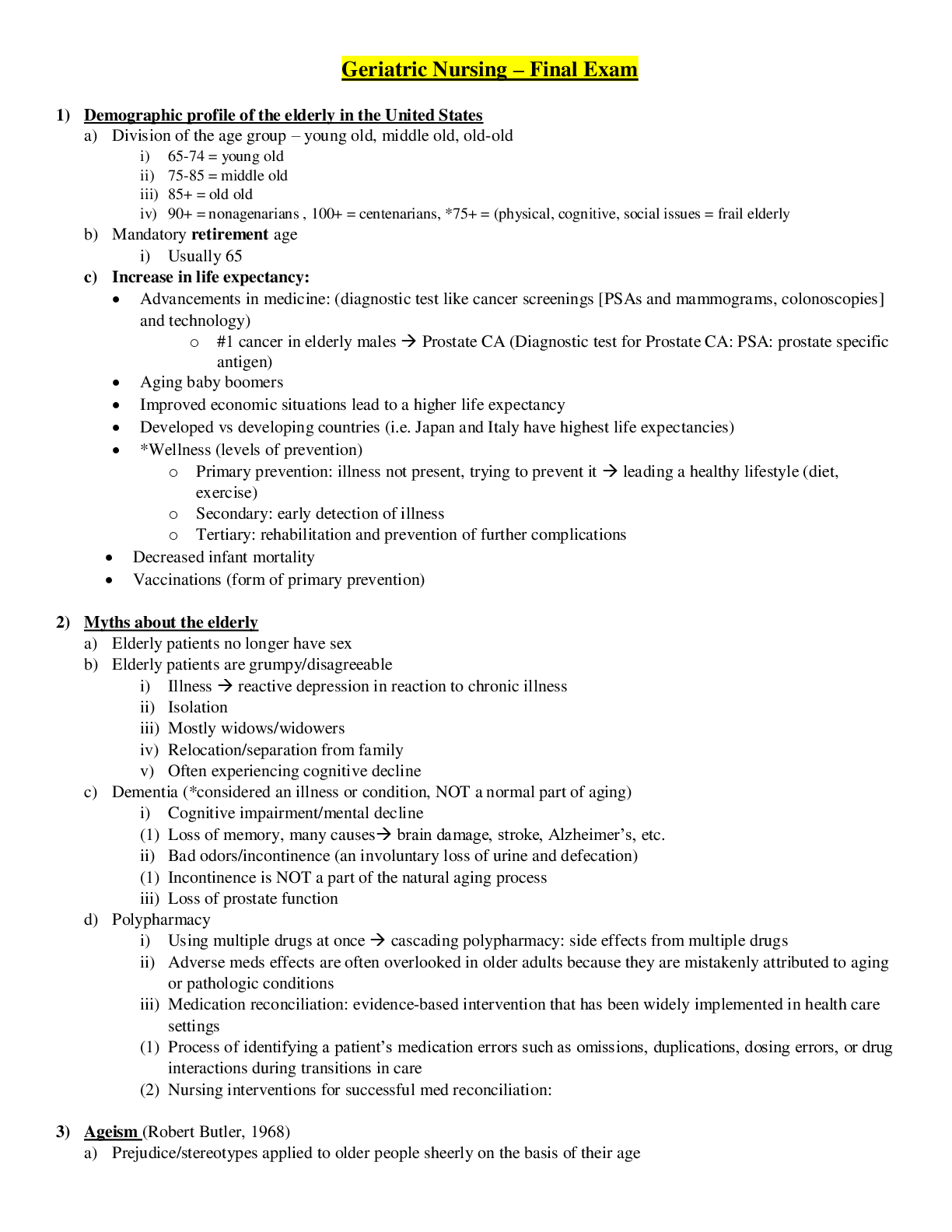
Buy this document to get the full access instantly
Instant Download Access after purchase
Add to cartInstant download
Reviews( 0 )
Document information
Connected school, study & course
About the document
Uploaded On
Dec 05, 2020
Number of pages
25
Written in
Additional information
This document has been written for:
Uploaded
Dec 05, 2020
Downloads
0
Views
31

